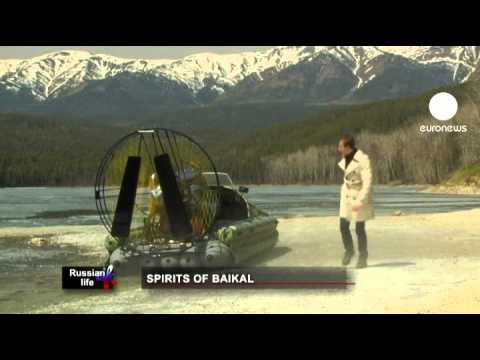In South-Eastern Siberia there is an amazing wonder of nature – Lake Baikal. It is so vast and deep that locals call it the sea. But its water is pure and fresh: a fifth of the Earth’s freshwater is contained in this lake.
Baikal is known as the “Pearl of Siberia”. It is home to thousands of species of plants and animals, two thirds of which can be found nowhere else on the planet. Despite environmental threats, the lake has preserved its purity – due partly to the lack of large-scale tourism.
Mikhail Ovdin, the director of the Trans-Baikal National Park told euronews: “We have about 30,000 visitors a year, mostly those who prefer extreme kinds of tourism, because our roads and hotels infrastructure is quite poorly developed so far. Everyone finds something special on Lake Baikal, something personal. Some come to admire its unique nature, others come for the fishing, or to relax with the family, or for scientific purposes – everyone has a different goal.”
Before approaching the shoreline one has to stop at a forest sanctuary to appease the lake’s guardian spirits with an offering of fish, milk and wine.
The existence of good and evil spirits in the visible world is the core belief of shamanism, inherent to the native people of Buryatia. At their ritual gatherings, shamans go into an ecstatic trance to communicate with the spirits and convey guidance from the supernatural realm.
Head of Tengeri Buryat Shaman Association Bair Zyrendorzhiev said: “Shamanism is the traditional belief of our people, the Buryat people, that our ancestors held from time immemorial, and our children will, I think, hold after us. Baikal is one of the holiest places for Siberian shamanists. The very nature and the spirit of the lake are full of energy that links every person and all his descendants to the global force of the universe, the earth and the people.”
The sacred lake the size of Belgium completely freezes over in winter. Some ice lingers till the end of May, and the whole area remains cool throughout most of the year, providing perfect conditions for its diverse flora and fauna.
The coast of the lake, which lies along a tectonic fault, is scattered with hot mineral springs. They are famed for their healing powers and have attracted people for centuries.
The zen tranquillity of the place resonates in another main religion of Buryatia.
Tibetan Buddhism co-exists with Shamanism and Christianity everywhere in the republic and its capital Ulan-Ude.
Anatoliy Zhalsarayev, an expert in religious organisations with the Buryatia local authorities, said: “Of course, there is some conflict of interests between the leadership of the Shamanists and Buddhists. But the bulk of the people don’t really care – they come both to the Buddhists and Shamanists whenever they need guidance: what’s most important for them now is to live in mutual harmony.”
Ancient beliefs and traditions have influenced Buddhism after it spread here in the 17th century. Today the Buryatian Buddhists revere Baikal’s pristine untouched nature as a sacred place for all humanity.
Traveler’s diary: the lake Baikal
Baikal’s Eastern shore is one of the most beautiful, though not easily reachable, destinations in Russia. The lake’s purity is amazing: its freshwater is so transparent one can see the ground 40 meters deep in the calm weather. The ring of hills and mountains surrounds the lake that reflects it like a mirror. It’s the middle of May, and some of the most picturesque bays are still covered in thin ice. Luckily for us, the national park rangers invite us on their airboat for a swift ride around several little islands: one offers magnificent views from the top of its forest-covered hill (we have been warned to stay aware of bears who sometimes can be seen around – we didn’t meet any though); on another one I enjoyed the opportunity to take a blissful sulphured hydrogen bath in a hot spring.
The place, swarming with rich wildlife, seems a wonderful destination for family vacations. Getting there, however, can be a challenge. The Eastern, most scenic shore of Baikal is about 5 driving hours away from the main city in the area, Ulan-Ude, and extensive parts of the road are as bumpy as a washboard. A solid vehicle is required, and the passengers must be strong and healthy enough to endure the travel. You can set up your tent in a designated area to live on the shore, but there aren’t any hotels for those preferring more comfortable rooms.
Still, the lack of tourist infrastructure doesn’t upset people working in the national park: this area is visited by about 30 thousand people a year as it is, and improving the road or building new hotels would probably bring many more, increasing the threat to the lake’s fragile environment. The rangers blame tourists for littering up the shore, and some of the locals for illegal fishing and hunting on the lake. While we were talking to Mikhail, the young director of the national park, he spotted two fishing boats setting up nets – most probably without official permission. He gave orders to investigate.
The lack of respect to the lake is shocking to many of the native Buryats – the people of Mongolian origin who joined the Russian empire 350 years ago. Traditionally they revere Baikal, glorifying it in their songs and poems as a living being having its will and spirit. It conforms to the ancient religion of the South-Eastern Siberia – the shamanism, still keeping its presence nowadays despite the more recent spread of Christianity and Buddhism and the decades of disfavour in Soviet times.
Local shamans invited us to their first big celebration of the year – the ritual opening of heavenly gates that summons the celestial spirits. Many dozens of followers were watching in excitement as the shamans, having put themselves in trance using drumbeat and vodka, were rushing about growling and speaking in tongues, supposedly possessed by the spirits who communicate with mortals through their bodies. A sacrifice sheep was startlingly slaughtered before our eyes without spilling any blood, as a shaman shove his arm elbow-deep in the cut in a belly to squeeze an artery thus stopping the animal’s heart.
By coincidence, it was also a big week for local Buddhists who were celebrating the birth, enlightenment and death of the Buddha in their temple complexes. Several of Russia’s regions are predominantly Buddhist, with Buryatia acknowledged as the centre of the following. The most important monastery – the Ivolginsky Datsan – hold a populous service giving the Buddhist believers a rare opportunity to see and worship the sacred Imperishable body of the Khambo Lama, who died in 1927 and was exhumed 75 years after his death, still sitting in the lotus position.
Both shamanists and Buddhists told us of their deep esteem towards the Lake Baikal, believed to be not just a wonder of nature but also a place of a great spiritual power. The pristine lake is the true heritage of the humanity that needs to be preserved for generations to come.





